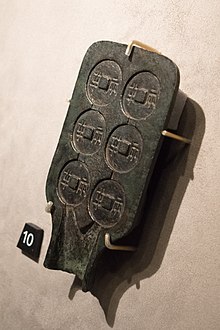Ban Liang

The Ban Liang (Traditional Chinese: 半兩 ; Pinyin: bàn liǎng) was the first unified currency of the Chinese empire. It was first minted as early as 378 BCE. The coin was introduced by the first emperor Qin Shi Huang around 210 BC.[1] It was round with a square hole in the middle. Before that time, many different coins were used in China. They were usually in the form of blades (knife money, spade money) . Round coins with square holes were used by the State of Zhou before it was ended by the Qin in 249 BCE.[2]
The Ban Liang was worth a "half tael" (半兩), or twelve zhu (銖, about 0.68 grams). It commonly weighs between ten and six grams.
Ban Liang coins were used under the Western Han dynasty until they were finally replaced by the Wu Zhu cash coins in 118 BC.
References[change | change source]
- ↑ "China: Ancient Tomb of First Emperor Qin Shi Huang's Grandmother Discovered in Xi'an". Mary-Ann Russon (International Business Times – United Kingdom). 11 September 2014. Retrieved 16 June 2017.
- ↑ Travel China Guide Qin & Han Money - Ban Liang Qian & Wu Zhu Qian. Retrieved: 14 June 2017.
